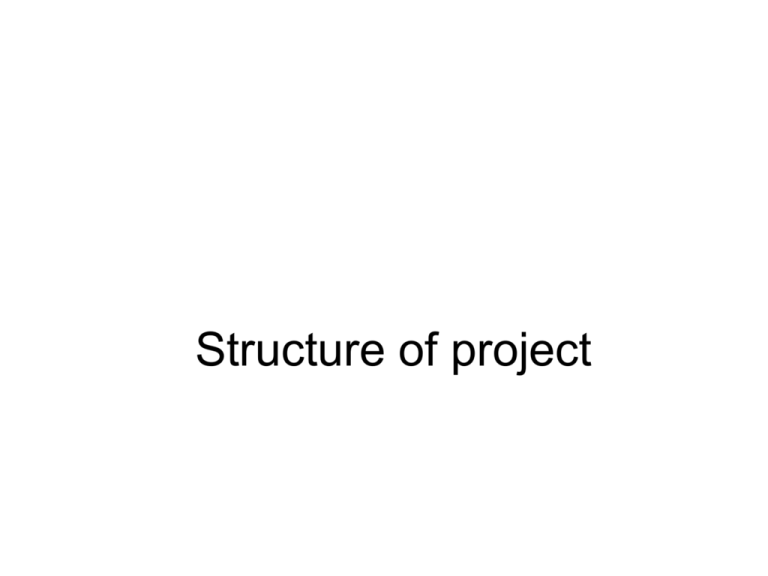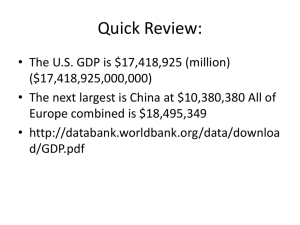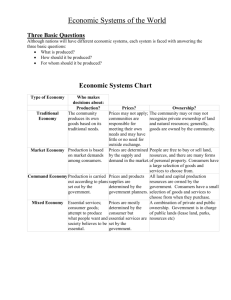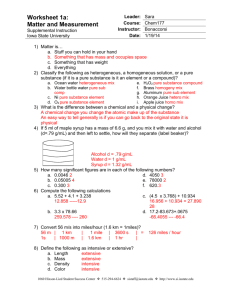Project Chart
advertisement

Structure of project The internal and external project management The internal project management is understood as a situation when the project team works entirely within the framework of the existing organizational structure. The external project management, on the other hand, is a situation when an external project head manager is brought in, who works as an external agent on the client’s behalf Typical external project management arrangement Organization Senior management Internal Project manager External project manager Functional manager Functional manager Resource Resource Functional team Functional team External consultants External suppliers External contractors External subcontractors Advantages and disadvantages of internal project management Advantages of internal project management: • a great flexibility in using personnel: • individual experts can be involved in a number of projects; • special knowledge is easily accumulating and spreading within the organization; Disadvantages of internal project management: • the project head manager needs much diplomacy in negotiating with functional managers about resources; • the violation of the principle of undivided authority; • making decisions, remuneration, etc. are in the field of tensions between a functional subdivision and the project team. Advantages of external project management the external project head manager can be hired for a required time; • the project team is subordinate disciplinarily to the project head manager; • functional structures of the organization exercise no influence on the work of the project team; • the project reacts quickly to the changes of environment; • the use of external specialists enriches the organization with new ideas and approaches; • jobs which cannot be done by appropriate specialists within the organization, can be entrusted to external experts; Disadvantages of the external project management • external specialists are usually expensive; • the communication is carried out through the borders of the organization (overcoming barriers); • the external manager’s goals may be far removed from those of the organization; • claims to external specialists and organizations are difficult to carry through, and the level of possible control over them and management of their activities is limited; • an additional administrative and controlling system is required as well as it is necessary to include into the project additional internal subdivisions (for example, a juridical department); • a stricter control over communications is required when they cross the borders of the organization. Communications with external specialists may lead to contractual complications; • no experience is accumulated inside the organization; Project organization The project within an existing organization Pure project structure • Pure project structures are typically used for projects that are difficult to plan accurately and where resource requirements and provision levels cannot be accurately established beforehand. Typical examples would include R&D projects. • In its simplest form a pure project system would have a “pool” of available labour resources that is maintained by the organization as a whole. The individual project managers can dip into this pool and draw a team of people together to become the project team. In large research and development organizations, there might also be a “pool” of project managers. • Project systems can operate as pure projects within a functional organization. A pure project would comprise a group of specialists who where drawn from functional units and have taken the responsibility for working on the project. The project within an existing organization Pure project structure • Pure project systems may be a “satellite” of a parent that has been set up specifically to deliver projects and could be linked to the parent company by a reporting system. Project organizations often have total freedom within the limits of final accountability; others have functional support assigned to them by their parent company. • Pure project structure can also exist as separate organization. This type of arrangements tends to exist for relatively large, one-off projects where project team members have responsibility solely to the project. The project itself is usually of relatively long duration. The project within an existing organization Pure project structure • The benefits of the pure project structure: – The system is flexible and responsive to change. – The project manager not only has full authority over the project but has a dedicated project team working under, and reporting only, to him. – The project team members report only to the project manager. They are not responsible to a functional department. – Pure project systems tend to have shorter and clearer formal (and informal also) communication linkages as there is no functional structure to navigate. The project manager reports directly to senior management. – These systems can be particularly effective when there are a number of projects operating at any one time within an organizations. This allows the project organization to build specific skills and expertise in these areas, which can result in distinct competitive advantages. The project within an existing organization Pure project structure – In pure project systems, the project team can develop a strong sense of identity and motivation; commitment to the project is often high. – Authority is centralized and the project team can therefore make quick decisions and react rapidly to changing circumstances. – It is easy to see the project as a whole, with less of a tendency to focus on sub-systems thus losing touch with the whole project. – It is generally much easier to incorporate external consultants than in a functional structure. The project within an existing organization Pure project structure • From the project’s point of view, the pure project system appears to be the best supporting structure. However, it has a number of disadvantages: – Several projects running concurrently may lead to a duplication of effort in some areas. – Staffing costs may be very high because each project has fulltime functional capability whether required or not. – Some degree of centralized direction is needed and there has to be some form of command hierarchy. Higher levels of authority may have difficulty in interfacing with various programs and projects. – Project managers (by definitions) tend to think ahead. There is often a tendency to bring in key resources early in order to ensure that they will be available when required and with no delay. This may lead to increased costs. The project within an existing organization Pure project structure – A sense of competition can sometimes develop between the various project teams. – Project team members tend to have an underlying concern about long term commitment. Project deadlines may create a culture where team members attempt to “cut corners” in order to maintain good performance records. – Pure project staff may become highly competent project workers, but prolonged absence from a corresponding functional section could result in their losing touch with developments within the functional disciplines. The functional department may be better positioned to keep up to date with developments. The functional organization The project within an existing organization The functional structure • Most projects are carried out within the traditional organization set out along the functional lines. • Although projects carried out in this environment might be strategically important to the organization, they are highly unlikely to be the reason for its existence. They are likely to be developmental in nature and would tend to be projects to improve methods or products. • The functional structure is typical of large organization, and it has some well known sufficient benefits: – Functional systems offer good flexibility in the use of people. Staff are primarily employed to perform a functional job but may be temporarily assigned to a project that requires their particular expertise. The project within an existing organization The functional structure – Functional systems allow individual experts to be effectively used on a number of projects. If there is a broad base of expertise within a functional department, they can be employed on different projects with relative ease. – Functional systems allow specialist knowledge to be easily shared within the function and effectively utilized by the project team. This assists in the development of continuity in the sense that expertise, procedures and administration are maintained within the function despite any personnel changes that may occur. – The function provides the most secure carrier path for an individual. Whilst projects may generate a degree of satisfaction, the functional department probably offers more prospect of promotion. The project within an existing organization The functional structure • From a project perspective there are also a number of disadvantages associated with the functional structure. The main of them: – It is inflexible. The strict lines of accountability and specialization tend to channel approaches and attitudes toward clearly defined functional roles. As a result functional units often find it difficult to innovate and respond to change. – The functional outputs tend to be primary objective of the organization. Any project structure that attempts to operate within the functional structure will tend to be considered as of secondary importance. – Cross-functional activities are discouraged. – Functional people tend to see the function as their future. Their carrier path are nearly always tied to the function rather than to any individual project. Matrix organization Matrix organization Matrix organization The project within an existing organization Matrix structure • A matrix structure represent a compromise between pure project and pure functional forms. It attempts to combine the benefits of the functional organization with those of the pure project organization, whilst at the same time eliminating the disadvantages. • The matrix structure is the pure project structure overlaid on the functional divisions of the parent organization. • The matrix structure is suitable for projects of all sizes and natures, where team members can be employed on, or assigned to, projects on either a full-time or a part-time basis whilst retaining their home in the functional discipline. • This arrangement is often referred to as internal nonexecutive, project management. It is internal because all aspects are within the organizational boundary. It is nonexecutive in that the project manager has limited (nonexecutive) authority within the system. The project within an existing organization Matrix structure Organizational boundary Senior managers Functional boundary Power boundary Functional manager Functional manager Resource Resource Project Manager Resource Resource Project team Project Manager Resource Resource Project team Functional team Functional team Project boundary The project within an existing organization Matrix structure • Matrix structures may be very strong or very weak, or anywhere in between, depending upon the nature of the projects undertaken. • Strong matrix structures close to pure project structures and tend to be used on large projects where employees are assigned to projects on long-term, full-time basis. • Weak structures exist where the only full-time employee on a project is the project manager and everyone else used on the project is commissioned on short-term basis. This is common on smaller, shorter-term projects. The project within an existing organization Matrix structure • The main characteristics of an internal project management structure are: – – – – – – – – – functional boundaries; power or status boundaries; organizational islands; a project sponsor; the project management chair; interfaces; interface management; the process of bidding; time recording and cost-center charging. The project within an existing organization Matrix structure • Advantages: – In matrix systems the project has a single person (i.e. the project manager) responsible for its success. – The project has reasonable access to the total capability of each of the functional areas and is well placed to draw on the services of any of the specialists across all the organization’s departments. – Team members are generally assured of their place back in the functional department. – The project within the matrix structure is flexible and can respond rapidly to demands of the client. – Close links to the functional departments ensure that organizational procedures and systems are well adhered to and are consistent across all projects. – Where there are several projects running simultaneously, a matrix structure enables better balancing of resources to meet the demands of the organization as well as the demands of each of the projects. The project within an existing organization Matrix structure • Disadvantages and problems: – In the case of the power struggle between project manager and functional managers, the project will suffer. – Team members often do not like having two bosses because it can lead to confusion and conflict. – Project management is a complex task in general and the matrix structure adds a new dimension to that complexity. – Project team members can sometimes have difficulty in readjusting to working back in a rigid functional unit on completion of the project. – Projects tend to be depleted of resources towards the end of the implementation life cycle. This can make completion very difficult. The project external to the existing organization • External project management tends to be more applicable to smaller organizations. It is a far more flexible approach and is much more suited to organizations with variable workloads. • External project management structures are sometimes referred to as “executive” project management structures. The term “executive” refers to the fact the project manager in this case is the only team leader and has full authority and control over all components of the project team. He does not have to negotiate for resources with functional managers. The project external to the existing organization • An external project management system could comprise only internal people but be managed by an external project management consultant; it could also comprise a mixture of internal people and external consultants, all of whom are managed by the consultant project manager; or it could comprise only external consultants, some or all of whom have been appointed by the consultant project manager. • In external system, different consultants act as agents on behalf of a client. Some or all of the consultants could work for different organizations. • External project management systems are susceptible to the problems of differentiation and sentience. • External project management systems also tend to be subject to more open and competitive fee structures than internal systems. The project external to the existing organization • External project management systems tend to have much more developed organizational linkages than any of the internal forms. • Authority links define the power and control structure that operates within the system. Authority links are not the same as contractual links; they need not necessarily follow the same routes through the organizational structure. • Communication links define the lines of communication in the system. They might follow the same paths as contractual and authority links, but they may also follow different paths. The project external to the existing organization • External project management systems tend to have a much wider range of formal contractual arrangements than internal systems. • In most cases, there would be a formal interacting body to act as a gateway between the organization and the outside world. • The project manager would generally interface with the externals through a legal service section. There may be also a change control section, which would monitor variation orders and give approval for changes as required by internal regulations or contracts. The project external to the existing organization Senior management Interface manager Functional manager Functional manager Resource Resource Change control section Resource Resource Legal services section Functional team Functional team External project manager External supplier Other external service providers External contractors Domestic subcontractors External subcontractors Nominated subcontractors External consultant External consultant The project external to the existing organization • External project management systems have a number of distinctive characteristics, which can be summarized as: – multidisciplinary and shared loyalty group characteristics; – fee structures; – external contractual linkages; – external non-contractual linkages. The project external to the existing organization Multidisciplinary and shared loyalty group characteristics • This type of a project management structure is usually a conglomeration of different companies and organizations that are working together as an alliance to satisfy the project objectives. • They are usually paid in the form of fees for their project management systems and therefore tend to be strongly multidisciplinary. • They are also susceptible to shared loyalty characteristics. Each consultant and contractor is working for his own practice or company. • The objectives of the practice or company are not the same as the objectives of the client. There will therefore sometimes be a conflict between parts of the system. • External project management systems more susceptible to the problems of differentiation and sentience than internal project management systems. The project external to the existing organization Fee structures • External project management systems tend to be subject to much more open and competitive fee structures than internal systems. • Negotiated fees are now generally accepted as normal for most applications. The client might require the various consultants to look at the project and make a bid in the form of a plan or proposal. This plan or proposal shows the bidder’s intended method of executing the project, together with a fee breakdown showing what fees would be payable and on what basis. The project external to the existing organization Fee structures • External fee structures can be based on either hourly rates or percentages. Percentage fees are usually based on some predetermined project cost total. Designer fees are often based on the measured works total. • Percentage fees may also be based on other totals, such as final account total, which includes all measured works, and additionally includes elements such as variation order totals, expended prime cost and provisional sums, etc. On large projects, the final account total can be double the measured works total. The project external to the existing organization External contractual linkages • External project management systems tend to have a much wider range of contractual arrangements than internal systems. This is because the external approach has a wider range of external team members and therefore a higher degree of risk of non-performance. • External involvement can be more or less risky depending on the degree of trust that is present. • Contracts are the most common approach to controlling risk where there is a significant external element. • The types and range of contracts used will depend on the specific application within the external system. The project external to the existing organization External contractual linkages • Generally, contractual linkages can take one of three primary forms: – Completion contracts. Completion contracts are generally one-off contracts where the contractor agrees to supply specific goods and services, usually at some kind of agreed cost and by a specific date. – Term contracts. Term contracts are long-term agreements. The supplier agrees to supply goods at an agreed rate to an agreed standard for a fixed term. – Service-level agreements. These are contracts where the level of service is set rather than the performance of a specific outcome. – All three forms of contracts can be priced and arranged through a competitive contract or through negotiation. Negotiated contracts are often used as extensions to existing contracts or where the work is highly specialized. The project external to the existing organization External contractual linkages • Within the classifications above, individual contracts may be of different types: – – – – Fixed-price contracts. Cost or cost-plus contracts. Reimbursement contracts. Target-price contracts. • Fixed price and cost contracts account for the majority of contracts issued in most industries. They represent the two extremes of risk for clients and contractors. The client’s risk is clearly greatest in the case of cost-plus contract, while it is lowest in the case of a fixed-price contract. The contractor usually compensates for this by increasing tender prices. The project external to the existing organization External contractual linkages • Individual contract types can take a number of different forms: – – – – Standard forms of contract. Professional services contracts. Supply contracts. Subcontract agreements. • Domestic subcontractor agreements. • Nominated subcontractor agreements. – Pro-forma contracts. The project external to the existing organization External contractual linkages • Typical contractual links in an external system would include the following: – – – – – Client to project manager and other design team members. Client to main contractor. Client to service authorities. Client to nominated subcontractors and suppliers. Client to local authority. These contracts are primarily regulated by statutory requirements. They include requirements such as mandatory inspections and the issue of certification such as a safety certificate. Most construction projects, for example, will generate a requirement for some form of planning permission and other statutory consents. The project external to the existing organization External non-contractual linkages • The contracts form the basic structure of the external system. However, external management systems cannot work effectively without additional links. These are authority links and communication links. • Authority links define the power and control structure that operates within the system. • In most external management structures the client would be at the head of the structure, and would relate instructions directly to the project manager. • In some cases, the client might devolve all authority to the project manager, in which case responsibility for all authority would be transferred. In other cases, the client might transfer 90% of authority, but retain strategic or milestone control over key stages. External non-contractual linkages Possible authority, contractual and communication arrangement for external consultants, with change control Advantages of the external project management • It is flexible and adaptive. • It can respond rapidly to change. • The use of external specialists can bring new ideas and approaches into the organization. • Areas of work where there is no in-house specialization can be outsourced to appropriate external specialists. • An appropriate structure can be established relatively quickly and easily and it can be staffed with the optimal range of specialists. • The team can be disbanded quickly and easily if workload or demand changes. • Internal risks such as key people being unavailable can be avoided. Disadvantages of the external project management • External specialists tend to be expensive. • External specialists have no loyalty to the organization or commitment to the project. • A whole new administrative and control system is required. The involvement of additional internal sections (such as legal services) may be required. • More rigid and controlled communication systems are required where communications cross the organizational boundary. Communications with external specialists can have contractual implications. • The risk profile of the organization in general and the project in particular changes significantly. There are possibility of arbitration and litigation. • The already complex job of the project manager becomes more complex still. Criteria for selecting the organizational structure • Authority. – The pure functional form uses a traditional reporting structure with a clear line of authority running down through the structure. Everybody has a clear set of objectives and there is a clear reporting line. – In the matrix structure individual team members have more than one reporting line. There is an immediate risk of confusion and contradiction. This means that more stringent communication and coordination systems are required. A new level of control through the project sponsor is required. The performance of individual sections becomes more difficult to assess. – In a pure project system it may be difficult to control a number of projects that are running concurrently. Criteria for selecting the organizational structure • Communication. – Formal communication is the easiest in a functional structure, but functional boundaries restrict the informal communication. Authority boundaries may restrict both formal and informal vertical communication. – A matrix structure reduces this blocks to some extent and particularly opens up formal cross-functional communications. – A pure project structure makes the greatest use of informal communications and offers the most flexible communication solution. Criteria for selecting the organizational structure • Knowledge transfer. – Functional knowledge is the easiest type of knowledge to store and use in future operations. – A matrix structure allows functional knowledge to be used in projects, and the projects themselves can develop new knowledge that can be fed back into the functional knowledge store. – Knowledge transfer in a pure project structure tends to be restricted to areas of commonality between individual projects. Criteria for selecting the organizational structure • Loyalty – A functional structure tends to develop the greatest individual loyalty, as employees tend to associate their carrier progression with the functional section. This can lead to situation in which the project may be seen as secondary. – In a matrix structure this loyalty can be shared to some extent as individual project team members remain members of their functional sections. – In a pure project structure individual progression may or may not be related to the success of individual projects. Loyalty may become a problem. Criteria for selecting the organizational structure Technology - Functional sections tend to rely on the use of existing technology in order to manufacture or produce something. - In a matrix structure the project teams are more likely to use existing technology to innovate. In addition, because project teams tend to look at problems in a different way they may generate a demand for new technological innovations or for the use of existing technology that has not previously been used by the organization. - Pure project structures tend to produce the greatest demand for innovative technology. Criteria for selecting the organizational structure • Cost – Pure functional structures tend to have large fixed costs. They are inflexible to changes in workload. – The matrix structure is more flexible in that the project teams can be increased or decreased in size depending on workload variations. – The pure project structure is the most flexible approach and can produce the lowest running costs. • Coordination – Pure functional structures have the most formal reporting systems and therefore the degree of coordination required is low. – In a matrix structure enhanced coordination is necessary because functional boundaries and increased potential for destructive competition and conflict. – Pure project structures require similar high levels of coordination in order to avoid the possibility of duplication of effort. Criteria for selecting the organizational structure • Support functions - Pure functional structures require well-developed centralized support functions. – Matrix structures have a similar requirement. Large projects may have their own administration and IT support. – Pure project organizations may require little or no centralized support. • In most cases, the organizational structure of the company is given, and the project manager has to design the project structure and then incorporate it into existing structure. Choice of organizational structure • A pure functional organizational structure should be chosen where: – – – – – – – – – – the workload is constant and only varies slightly; projects are required only infrequently; there are well developed centralized support functions; clearly defined authority structures are required; informal communication systems are not required; there is adequate back-up for key personnel; the functional objectives are the primary concern of the organization; change is unlikely to be a major consideration; any projects are relatively small or insignificant; fast project response time is not required. Choice of organizational structure • A matrix organizational structure should be chosen where: – – – – – – – – – – workload is variable; projects are frequently required; a degree of research and innovation is required; centralized support functions are present or partially outsourced; split authority structure are acceptable; informal communication systems are acceptable; projects are secondary but of significant importance; some degree of change has to be accommodated; any projects are small to medium size; fast project response time is not generally required.






